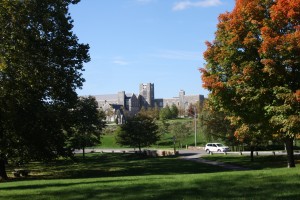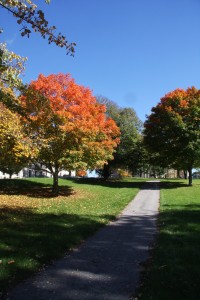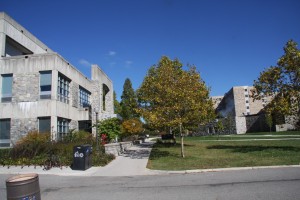 Being on an extended research visit to one of the world’s Mekkas of Forest Biometrics, Virginia Tech at Blacksburg, I cannot help but notice quite a few differences to European Forest Biometrics. I am currently based on this vast and beautiful campus, where in autumn the tree leaves almost seem to be on fire and the warm, orange-red colour of the leaves forms a nice contrast to the limestone facades of the campus buildings. The sunny, warm weather at this time of the year is just awesome. Through the window of the coffee shop, where I am writing this blog, I can see the students passing by. Many wear T shirts and sweaters with Virginia Tech logos on them. Maroon and orange everywhere. The identification with this University is amazing, also among the general public in town across all age classes. This is my second visit to Blacksburg, this time representing the Swedish University of Agricultural Sciences.
Being on an extended research visit to one of the world’s Mekkas of Forest Biometrics, Virginia Tech at Blacksburg, I cannot help but notice quite a few differences to European Forest Biometrics. I am currently based on this vast and beautiful campus, where in autumn the tree leaves almost seem to be on fire and the warm, orange-red colour of the leaves forms a nice contrast to the limestone facades of the campus buildings. The sunny, warm weather at this time of the year is just awesome. Through the window of the coffee shop, where I am writing this blog, I can see the students passing by. Many wear T shirts and sweaters with Virginia Tech logos on them. Maroon and orange everywhere. The identification with this University is amazing, also among the general public in town across all age classes. This is my second visit to Blacksburg, this time representing the Swedish University of Agricultural Sciences.
Obviously the US are a big country and there are quite some differences in how Forest Biometrics is run up and down the country. However, a lot of the research over here appears to be tailored to the needs of forest industry. Interestingly this does not necessarily mean that research remains at a practical level or that research methods are simplified, on the contrary!
Private funding plays an important role in US research compared to the largely state-funded research in Europe (possibly with the exception of the UK). As a consequence industry and research representatives join their efforts in so-called research cooperatives. The industry partners pay a kind of membership fee that university researchers are free to use for the best intents and purposes and the coop members benefit from any new releases in terms of publications, models and software. This is a set-up I have always admired since I heard about it for the first time. The industry-driven funding stream also contributes to the fact that growth and yield science still plays a large role in the US, very much in contrast to Europe. Flexible, computer-implemented growth and yield models addressing current issues such as climate change, genetic tree breeding programmes but also traditional topics such as spacings and fertilisation are high in demand. Often these growth and yield models are required to go far beyond the level of growth simulators to become decision-support systems that allow the precise management planning of huge forestry companies. For collecting data, forest biometricians and even silviculturists work more with statistically designed experiments over here and less with observational plots as in Europe. In the south of the country, most research work is in the context of plantation forestry rather than in natural forests. And forest management in these plantations is highly optimised, running by the clock.
 Forest Biometrics in many parts of the US largely focuses on synthesising growth patterns by using the latest statistical techniques for empirical, data-driven modelling. Research into fundamental growth processes and ecological questions is therefore often just a small byproduct. Regular conferences in this subject area (often traditionally associated with the term “mensuration”) are also visited by private consultants and company representatives. as a result there is an interesting exchange of opinions and thoughts in discussions.
Forest Biometrics in many parts of the US largely focuses on synthesising growth patterns by using the latest statistical techniques for empirical, data-driven modelling. Research into fundamental growth processes and ecological questions is therefore often just a small byproduct. Regular conferences in this subject area (often traditionally associated with the term “mensuration”) are also visited by private consultants and company representatives. as a result there is an interesting exchange of opinions and thoughts in discussions.
Forest biometricians are well respected in America and are even explicitly mentioned in books of forest history as I have recently discovered. Blacksburg, for example, is the location of the school (of thought) of Prof. Harold Burkhart, who in turn is a student of Prof. Jerry Clutter (University of Georgia). Like in Europe, there are interesting academic lines of succession or academic family trees. A recently published book on the history of forestry in the southern US describes the development of forest biometrics in this part of the world including all the aforementioned relationships on several pages. This is indeed very remarkable and unprecedented in similar European publications.
 It has been great fun here so far thanks to my hosts and colleagues at Virginia Tech including Harold Burkhart, Phil Radtke and Randy Wynne. I started with participating in a conference of the Southern Mensurationists (where I gave talks on my recent growth dominance research at Bialowieza Forest and on human tree selection behaviour) and then stayed on to carry out joined research with Harold Burkhart. Together we are currently working on modelling size-dependent relative growth rates. This is very inspiring and takes the work my colleague Anders Muszta and I previously did in this field to a new level.
It has been great fun here so far thanks to my hosts and colleagues at Virginia Tech including Harold Burkhart, Phil Radtke and Randy Wynne. I started with participating in a conference of the Southern Mensurationists (where I gave talks on my recent growth dominance research at Bialowieza Forest and on human tree selection behaviour) and then stayed on to carry out joined research with Harold Burkhart. Together we are currently working on modelling size-dependent relative growth rates. This is very inspiring and takes the work my colleague Anders Muszta and I previously did in this field to a new level.
Great post Arne! If you ever want to see how forestry, and specifically biometrics, differs between the southeastern and southwestern US (where the focus of the latter is public land management, industry’s influence is minimal, and natural disturbances are an undeniable and constant threat) let me know. Also, the Grand Canyon is only an hour away…
Unrelated – Thanks for sending me the tree selection-social science paper and the copies of your recent work on relative growth. I’ve been a longtime admirer of your work (especially the point pattern work) and I eagerly await what you put out next. Highly relevant stuff for my work…